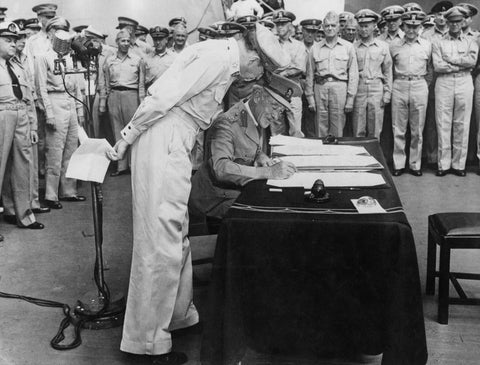
How a One-Eyed Canadian Almost Ruined the Japanese Surrender of WWII
“We are gathered here, representatives of the major warring powers, to conclude a solemn agreement whereby peace may be restored,” came Gen. Douglas MacArthur’s strong, yet husky voice, cutting through the warm breeze of Tokyo Bay on Sept. 2, 1945.
Marked both by jubilation and somber reflection, the Japanese surrender at Tokyo Bay officially concluding the bloodiest war in recorded history — but it wasn’t without incident, thanks to our Canadian allies.
The Best-Laid Schemes …
The Americans had planned the Japanese surrender meticulously. Unlike the German surrender in Reims, which transpired in a room in a school building, in the middle of the night, the Allies in the Pacific had grander plans.
As morning dawned, the vast expanse of Tokyo Bay teemed with 258 warships, with the main carrier task forces standing vigil out at sea in case of Japanese treachery.
“Aboard the Missouri,” historian Richard B. Frank wrote, “on seemingly every available overlook, clustered ‘citizen sailors’ in their whites, with a sprinkle of khaki-clothed Leathernecks from the ship’s Marine detachment. They were the proud representatives of all those in uniform who had overwhelmingly carried the battle to the face of the enemy and paid the highest price.”
The USS Missouri’s captain, Stuart S. Murray, even went so far as to ask several sailors to strap mop handles to their legs so as to better estimate the time required for Japanese Foreign Minister Mamoru Shigemitsu, who had a wooden leg, to make his way from the destroyer to the veranda deck, where the surrender would occur, according to Frank.
The blank line where Col. Lawrence Moore Cosgrave was
supposed to sign can be seen on the document’s right-hand page, along with
Gen. Richard Sutherland’s handwritten corrections. (Diplomatic Record
Office/Ministry of Foreign Affairs Japan)
… Gang Aft AGley
But even the most meticulous of planners couldn’t predict what occurred next.
The British — clearly familiar with the smells of rich mahogany but unfamiliar with the American motto that bigger is better — had furnished an elegant wooden table for momentous occasion of the signing of the instruments of surrender. But when the documents arrived that morning, they were too large for the surface.
A simple mess table — coffee stains and all — was swapped in instead.
The “glum-faced” Japanese delegation, as war correspondent T.L. Deglin later wrote, arrived punctually at 8:56 a.m.
“A million eyes seemed to beat on us with the million shafts of a rattling storm of arrows barbed with fire,” recalled Japanese diplomat Toshikazu Kase. “Never have I realized that the glance of glaring eyes could hurt so much. We waited … standing in the public gaze like penitent boys awaiting the dreaded schoolmaster.”
'Ope, Sorry’
Amid the solemnity and grandeur of the occasion, however, came an unusual historical footnote courtesy of the Canadian representative, a half-blind World War I veteran by the name of Col. Lawrence Moore Cosgrave.
There were two copies of the instrument of surrender to sign, and when it came time for Col. Cosgrave to put pen to paper to sign the Japanese copy, he, perhaps owing to his one blind eye, scrawled his name in the space reserved for the French delegate.
In videos of the ceremony, a brief but noticeable delay occurs after the French delegate sits down and gazes confusedly at the sheet of paper.
“Each subsequent delegate eventually signed on the next available — if incorrect — line; the final delegate from New Zealand simply signing his name in a blank space underneath the others, his signature line having been commandeered by the Dutch,” wrote The Globe and Mail reporter Allan Richarz.
Invalid Entry?
The mistake caused a minor kerfuffle, with the Japanese delegation protesting that they could not accept a blemished document. MacArthur’s famously brusque chief of staff, Gen. Richard Sutherland, huddled with Kase, Shigemitsu and several other American officers before Sutherland “sat down, drew lines through the printed names of the Allied representatives and wrote the correct names beneath the errant signatures,” historian Ian Toll wrote Doubling down, Sutherland added his initials to each correction to prevent any further Japanese obstruction. The Japanese accepted the updated document.
Sutherland later said ~~~~ that he suspected that “very few people would ever see it anyway, since it probably would be buried in the deepest recesses of their most secret archives.”
He was right: For the most part, Cosgrave’s blunder remains a minor postscript to one of the most important dates of the 20th century.
historynet magazines
Our 9 best-selling history titles feature in-depth storytelling and iconic imagery to engage and inform on the people, the wars, and the events that shaped America and the world.
